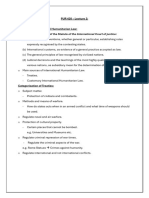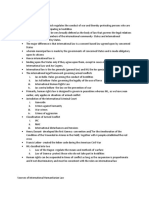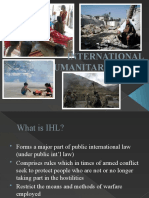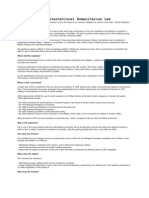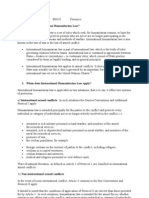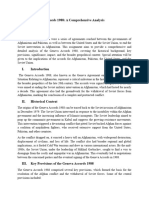0 ratings0% found this document useful (0 votes)
7 viewsIhl 2
Ihl 2
Uploaded by
ZerayohannesCopyright:
© All Rights Reserved
Available Formats
Download as PPTX, PDF, TXT or read online from Scribd
Ihl 2
Ihl 2
Uploaded by
Zerayohannes0 ratings0% found this document useful (0 votes)
7 views11 pagesOriginal Title
IHL 2
Copyright
© © All Rights Reserved
Available Formats
PPTX, PDF, TXT or read online from Scribd
Share this document
Did you find this document useful?
Is this content inappropriate?
Copyright:
© All Rights Reserved
Available Formats
Download as PPTX, PDF, TXT or read online from Scribd
Download as pptx, pdf, or txt
0 ratings0% found this document useful (0 votes)
7 views11 pagesIhl 2
Ihl 2
Uploaded by
ZerayohannesCopyright:
© All Rights Reserved
Available Formats
Download as PPTX, PDF, TXT or read online from Scribd
Download as pptx, pdf, or txt
You are on page 1of 11
What is International Humanitarian Law?
Definition: International Humanitarian Law is a
sub-branch of public international law that seeks
to limit the humanitarian consequence of armed
conflicts.
It comprises rules of international law which
establish minimum standard of humanity that must
be respected in any situation of armed conflict
Nomenclature/Terminology
The law of war
The law of armed conflict
International humanitarian
law( the prevailing approach these
days
Scope and Nature of International
Humanitarian Law
• The applicability of IHL/jus in bello/ is irrespective
of the arguments of the rules of jus ad bellum
• It’s is also applicable irrespective of the legality of
the war. The fact that the war violates international
law doesn’t matter.
• The recognition or otherwise as to the existence of
war by one of the parties to the conflict or by the
international community is immaterial for the
applicability of IHL/Common Art 2 to the four GCs/
Cont’’’’d
• IHL works based on the principle of equality of
belligerent parties. This means IHL is equally
binding on all parties to an armed conflict,
irrespective of their motivations or of the nature or
origin of the conflict.
• IHL does not prevent/stop/ war from being
happened. What it does rather is regulating the
conduct of hostilities. It recognizes war.
• It’s also applicable irrespective of the recognition of
the state. E.g 1967(Arab-Israel war)
Purpose of IHL
• The ultimate purpose of IHL is balancing military
necessity and of humanity.
• IHL makes clear that military necessity does not
give the belligerents carte blanche/unlimited
discretion/ to wage unrestricted war.
• Rather consideration humanity imposes certain
limits on the means and method of warfare, and
requires that those who fallen into enemy hands be
treated humanly at all times.
Sources of IHL
The sources of public international law provided under Art 38(1)(a) of
the statue of the International court of Justice(ICJ) are also sources of
IHL.
1) Treaties: IHL is one of the most densely codified branch of
international and that treaties remains the most relevant sources.
• A treaty law could be bilateral or multilateral
• All most all treaty laws of IHL are multilateral treaties.
a. Geneva Convention I
b. Geneva Convention II
c. Geneva Convention III
d. Geneva Convention IV
Contt’’’d
a. Additional protocol I to the 4 GCS
b. Additional Protocol II to the 4GCs
c. Hague regulation of 1899 and 1907
d. Convention on Certain conventional
Weapons (1980)
e. Convention on Cluster Munitions
(2008)
Contt’’’d
2) Customary IHL:
• Customary rules of IHL are applicable to both
international and non international armed conflict
• But there has to consistent state practice/the
objective element/and opinio juris/the subjective
element
• A state or an armed group could be bound by
customary IHL even if it is not a party to treaty IHL
rules.
• Currently we have more than 161 customary IHL
rules, according to the ICRC.
Contt’’’’’d
3) General principles of Law(No clear definition as
to what constitute GPL)
4) Case laws (It could be a decision rendered by a
national, regional or international tribunal)
5) Writing of Scholars (not every publication could
serve as source of IHL)
6) Other “soft laws” (Interpretations of IHL given by
international organizations and states)
The Relationship between IHL and
other International Laws
• IHL and International Human Rights
Law(IHRL)
• IHL and international Criminal Law
• IHL and the International of use of
Force
You might also like
- The Sword and The Olive - A Critical History of The Israeli Defense Force (PDFDrive) PDFDocument506 pagesThe Sword and The Olive - A Critical History of The Israeli Defense Force (PDFDrive) PDFЯна БевзюкNo ratings yet
- Kartilya NG Katipunan by Emilio JacintoDocument7 pagesKartilya NG Katipunan by Emilio JacintoJvc CawiliNo ratings yet
- Judge Dredd - Apocalypse DawnDocument99 pagesJudge Dredd - Apocalypse DawnSyrus Hix100% (6)
- IHL-PPT latest-1Document95 pagesIHL-PPT latest-1Muluken AmareNo ratings yet
- International Humanitarian LawDocument14 pagesInternational Humanitarian Lawleslieca1511No ratings yet
- Contemporary Challenges in IHLDocument28 pagesContemporary Challenges in IHLharini weerasingheNo ratings yet
- 2021 Law of Armed ConflictDocument47 pages2021 Law of Armed ConflictGloriaNo ratings yet
- Ihl Exam NotesDocument40 pagesIhl Exam NotesSarthak JainNo ratings yet
- Topic 4 International (IAC) & Non-International Armed Conflict (NIAC)Document35 pagesTopic 4 International (IAC) & Non-International Armed Conflict (NIAC)riasat.azim9No ratings yet
- SIxtine Schaffers - LOAC - 2022-2023Document75 pagesSIxtine Schaffers - LOAC - 2022-2023Chris GreenSoulNo ratings yet
- 2012 Lecture 1 Intro To Ihl and Qualification - HandoutDocument40 pages2012 Lecture 1 Intro To Ihl and Qualification - Handoutmustebedaso123lawyerNo ratings yet
- Origin and Sources of IHLDocument11 pagesOrigin and Sources of IHLJoker PrankNo ratings yet
- PUR 420 - Lecture 2Document5 pagesPUR 420 - Lecture 2kalmkraftersNo ratings yet
- Ihl 2Document59 pagesIhl 2Sarthak JainNo ratings yet
- Internalization of NIACDocument12 pagesInternalization of NIACAmina KimweriNo ratings yet
- IHL ProjectDocument35 pagesIHL ProjectSahil Ahmed JameiNo ratings yet
- HR LAW - Lecture 10Document14 pagesHR LAW - Lecture 10Saqlain HyderNo ratings yet
- Introduction of IHLDocument34 pagesIntroduction of IHLDIPESH NASSANo ratings yet
- Sample Questions 2Document205 pagesSample Questions 2alexNo ratings yet
- International Humanitarian Law 101Document44 pagesInternational Humanitarian Law 101brandny8No ratings yet
- CH. 1- Introduction to International Humanitarian Law (2)-1Document74 pagesCH. 1- Introduction to International Humanitarian Law (2)-1tikurcastro1No ratings yet
- IHRL and armed conflict class notes and discussion question week of 16thDocument6 pagesIHRL and armed conflict class notes and discussion question week of 16thJohnNo ratings yet
- Law of War (Intro.)Document9 pagesLaw of War (Intro.)kartik.law26No ratings yet
- A. Mabini Campus, Sta. Mesa, City of Manila College of Law: Polytechnic University of The PhilippinesDocument36 pagesA. Mabini Campus, Sta. Mesa, City of Manila College of Law: Polytechnic University of The PhilippinesAriel Joseph NicolasNo ratings yet
- LLB Hons. PU Week 3 War, Armed Conflicts and Other HostilitiesDocument46 pagesLLB Hons. PU Week 3 War, Armed Conflicts and Other HostilitiesJannah SaeedNo ratings yet
- 2023-2024 War - Homework International Criminal Law Session 2Document212 pages2023-2024 War - Homework International Criminal Law Session 2alexNo ratings yet
- The Systematic Mechanism of WarfareDocument252 pagesThe Systematic Mechanism of WarfareshaikhabeeraalviNo ratings yet
- Ihl & Source of IhlDocument5 pagesIhl & Source of Ihlmohd saadNo ratings yet
- Intl Armed ConflictDocument13 pagesIntl Armed ConflictRanu MishraNo ratings yet
- Notes On IHLDocument7 pagesNotes On IHLFrankel Gerard MargalloNo ratings yet
- Laws On Armed Conflict: Saint Louis University School of LawDocument11 pagesLaws On Armed Conflict: Saint Louis University School of LawRampage Dx100% (1)
- Ihl (2007)Document75 pagesIhl (2007)geronsky06No ratings yet
- ABC of International Humanitarian LawDocument44 pagesABC of International Humanitarian LawAmelyn Albitos-Ylagan MoteNo ratings yet
- International Humanitarian LawDocument3 pagesInternational Humanitarian LawJoSebastianNo ratings yet
- History and ClassificationDocument6 pagesHistory and Classificationdinesh rokkaNo ratings yet
- International Law Icc and IhlDocument18 pagesInternational Law Icc and IhlMJ AroNo ratings yet
- IHL PrinciplesDocument41 pagesIHL PrinciplesD Del Sal0% (1)
- RONA, Gabor. Legal Frameworks To Combat Terrorism - 2005Document13 pagesRONA, Gabor. Legal Frameworks To Combat Terrorism - 2005sergio tavaresNo ratings yet
- Power Point Week 1Document34 pagesPower Point Week 1Ivan HortalNo ratings yet
- International Humanitarian LawDocument3 pagesInternational Humanitarian Lawjelly daleNo ratings yet
- DCA SynthèseDocument54 pagesDCA SynthèseN ZNo ratings yet
- The Basics of International Humanitarian LawDocument2 pagesThe Basics of International Humanitarian LawJames HullanaNo ratings yet
- International Humanitarian LawDocument6 pagesInternational Humanitarian LawFrancis Ray Arbon FilipinasNo ratings yet
- The Scope and Application of InternationDocument4 pagesThe Scope and Application of InternationAbir N ZainNo ratings yet
- Armed ConflictDocument13 pagesArmed ConflictSakshi PoddarNo ratings yet
- International Humanitarian LawDocument30 pagesInternational Humanitarian LawDaphne Angela Logarta Ortezuela100% (2)
- Soci 111 Updated NotesDocument57 pagesSoci 111 Updated NotesViky NstainNo ratings yet
- IL International Humanitarian LawDocument13 pagesIL International Humanitarian LawSycelle Lou Patrick100% (1)
- PUR 420 - Lecture 1Document7 pagesPUR 420 - Lecture 1kalmkraftersNo ratings yet
- PIL Chapter14Document36 pagesPIL Chapter14Juris PoetNo ratings yet
- International Humanitarian Law Project Internal Disturbance and IHLDocument19 pagesInternational Humanitarian Law Project Internal Disturbance and IHLSabir Saif Ali ChistiNo ratings yet
- NEW NOTES ON IHLPDFDocument43 pagesNEW NOTES ON IHLPDFmurimibrian785No ratings yet
- Humantarian and Refugee LawDocument59 pagesHumantarian and Refugee LawShahnoor Ali 7452 KCLF 18No ratings yet
- International Humanitarian LawDocument19 pagesInternational Humanitarian LawAbdi RetaNo ratings yet
- Decolonizing IHL_ESDR_17 Nove 2024 (2)Document32 pagesDecolonizing IHL_ESDR_17 Nove 2024 (2)Manisha PandayNo ratings yet
- IHL PresentationDocument56 pagesIHL Presentationbrian kaile garmaNo ratings yet
- Lecture 8 International Criminal War CrimesDocument15 pagesLecture 8 International Criminal War CrimesDuncan WachiraNo ratings yet
- Ihl and IhrlDocument2 pagesIhl and IhrlPriyanka DevershettyNo ratings yet
- INTRO: International Humanitarian Law and International Human Rights LawDocument18 pagesINTRO: International Humanitarian Law and International Human Rights LawRhodaNo ratings yet
- Week 10 Sources 22062024 112454amDocument20 pagesWeek 10 Sources 22062024 112454amSardar Hassan SudozaiNo ratings yet
- Rule of Law in Armed Conflicts Project: Warfare's Legal Frontiers, Navigating Conflict ZonesFrom EverandRule of Law in Armed Conflicts Project: Warfare's Legal Frontiers, Navigating Conflict ZonesNo ratings yet
- War Crime: Unveiling the Shadows, The Hidden Ethics of Modern WarfareFrom EverandWar Crime: Unveiling the Shadows, The Hidden Ethics of Modern WarfareNo ratings yet
- Military Surrender: Strategic Strife, Decoding the Anatomy of ConcessionsFrom EverandMilitary Surrender: Strategic Strife, Decoding the Anatomy of ConcessionsNo ratings yet
- The Story Behind The Star Spangled BannerDocument2 pagesThe Story Behind The Star Spangled BannerHannah ValbertNo ratings yet
- Marina Academic Calender 2024Document1 pageMarina Academic Calender 2024iherb3abc3No ratings yet
- Final ExamDocument14 pagesFinal ExamArthur AnthamNo ratings yet
- Iraq Actors of Protection 2018Document110 pagesIraq Actors of Protection 2018Pepin TtdNo ratings yet
- Geneva AccordsDocument4 pagesGeneva AccordsGirly placeNo ratings yet
- Wargames Illustrated #113Document60 pagesWargames Illustrated #113Анатолий Золотухин100% (1)
- HIS103.Final AssignmentDocument10 pagesHIS103.Final AssignmentSazzad66No ratings yet
- Roy AcoyDocument17 pagesRoy AcoyRazul AcoyNo ratings yet
- Arc-164 ManualDocument140 pagesArc-164 Manualj.wennikNo ratings yet
- Facharbeit NotesDocument7 pagesFacharbeit NotesEliasNo ratings yet
- World History 2147, Shayaan.Document15 pagesWorld History 2147, Shayaan.Ifrah DarNo ratings yet
- Mosin Nagant Parts InterchangeabilityDocument13 pagesMosin Nagant Parts Interchangeabilitygreaternorthroad8820100% (2)
- FM 3-3 - FMFM 11-17 - CHEMICAL AND BIOLOGICAL CONTAMINATION AVOIDANCE 16 November 1992Document293 pagesFM 3-3 - FMFM 11-17 - CHEMICAL AND BIOLOGICAL CONTAMINATION AVOIDANCE 16 November 1992nuclearsecrecyNo ratings yet
- The Second Triumvirate: Exam Tip: Source SkillsDocument3 pagesThe Second Triumvirate: Exam Tip: Source Skillsd cornsNo ratings yet
- LitCharts DisabledDocument17 pagesLitCharts DisabledAadhyaagauli2007gmail.com MydearpapaNo ratings yet
- Thyroid Gland and Adrenal Gland Physiology BAMS Digital LearningDocument10 pagesThyroid Gland and Adrenal Gland Physiology BAMS Digital LearningLight King ChaudharyNo ratings yet
- SERENITY RPG Rules Clarifications/Revisions (V5.0) : Rules For Combat (Revised To Be Compatible With CORTEX System RPG)Document7 pagesSERENITY RPG Rules Clarifications/Revisions (V5.0) : Rules For Combat (Revised To Be Compatible With CORTEX System RPG)htm.sys100% (1)
- History 7 Role of NepalDocument3 pagesHistory 7 Role of NepalDevkota SunilNo ratings yet
- Tercio Rule SheetDocument1 pageTercio Rule SheetPredrag Judge StanišićNo ratings yet
- FN Herstal FN Mag - Std.enDocument12 pagesFN Herstal FN Mag - Std.enlara.ndi16401No ratings yet
- 12/8/05 by Dan Verssen: Twas The Night Before ChristmasDocument7 pages12/8/05 by Dan Verssen: Twas The Night Before ChristmasZyxpsilonNo ratings yet
- Malbrook Large Battles Charts QRS 2Document2 pagesMalbrook Large Battles Charts QRS 2Steven TaylorNo ratings yet
- Course Descriptions Formal SchoolsDocument5 pagesCourse Descriptions Formal Schoolschidseymatt100% (1)
- Catalogo Xbox 360-1Document50 pagesCatalogo Xbox 360-1Melissa PangsriNo ratings yet
- Class 8 - History and Civics - The Conquest of Bengal (Longman Pearson) - ICSE STUDY GUIDEDocument19 pagesClass 8 - History and Civics - The Conquest of Bengal (Longman Pearson) - ICSE STUDY GUIDEAkki's worldNo ratings yet
- Đề Thi Vào 10 2021 Môn Tiếng AnhDocument5 pagesĐề Thi Vào 10 2021 Môn Tiếng AnhK60 Đỗ Khánh NgânNo ratings yet
- Art and Science of Leadership 7th Edition Afsaneh Nahavandi Test Bank 1Document36 pagesArt and Science of Leadership 7th Edition Afsaneh Nahavandi Test Bank 1damonmitchellosnqbpargy100% (39)












